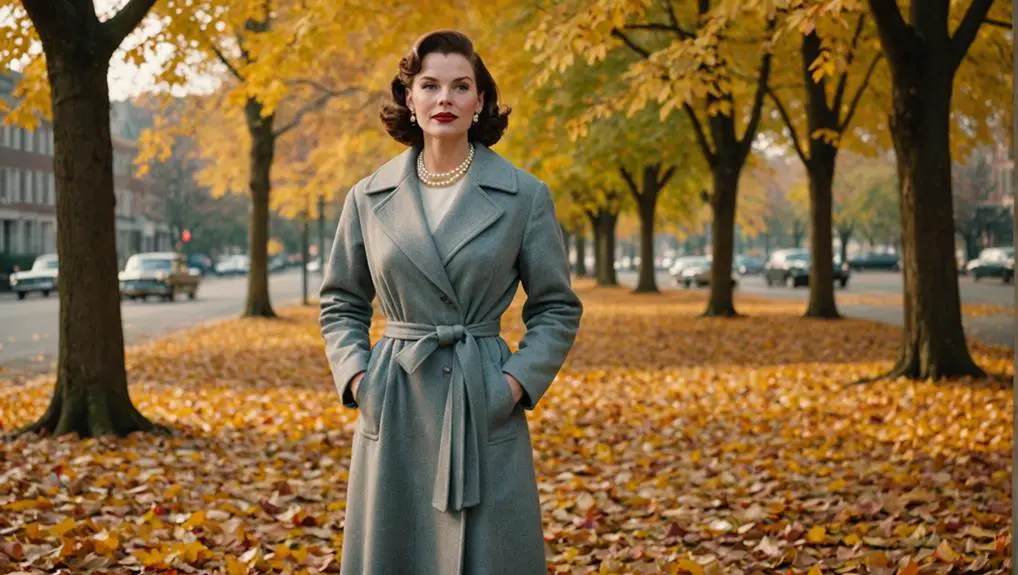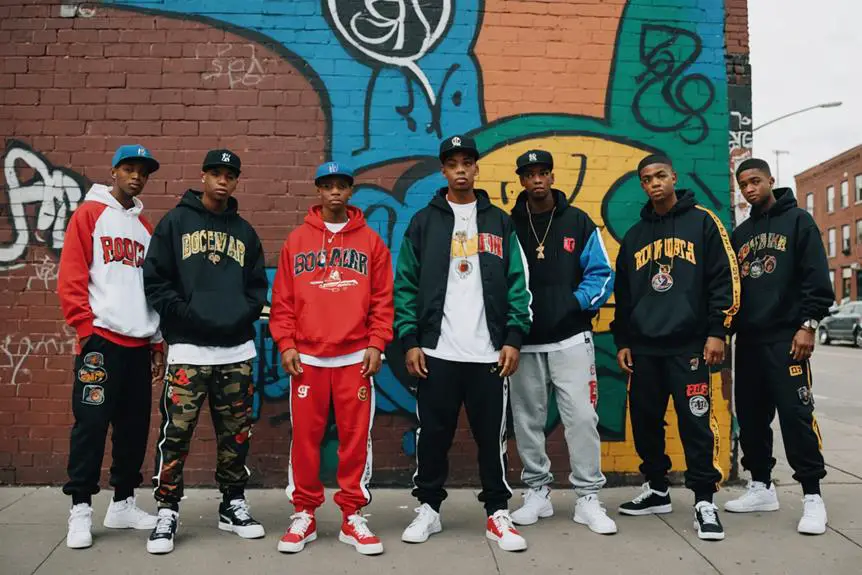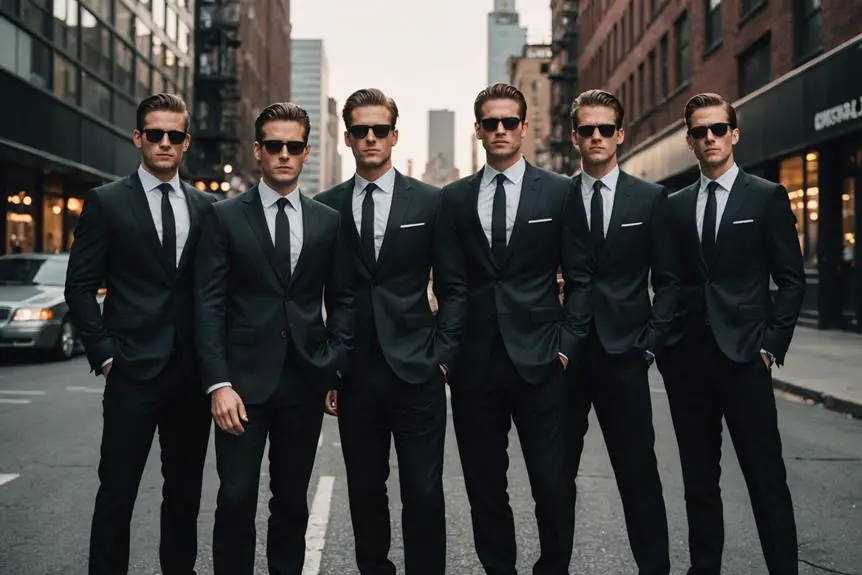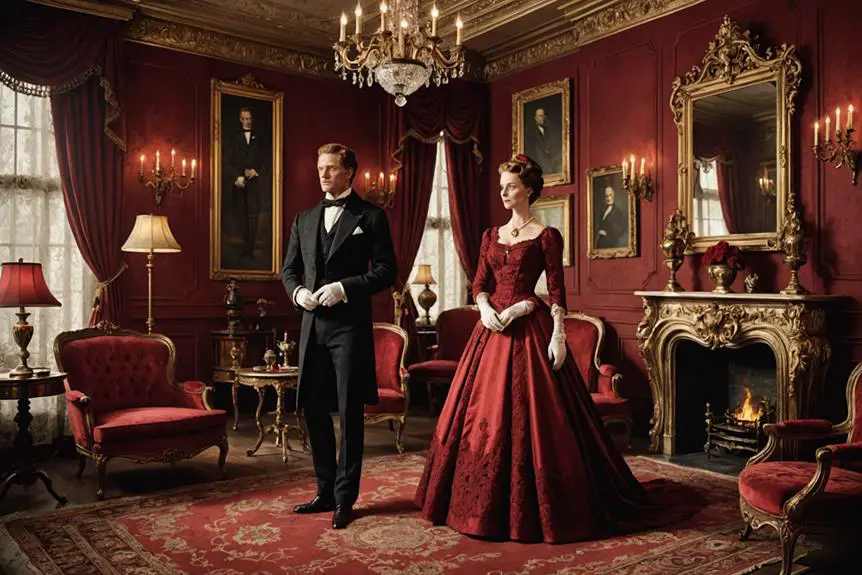In the 1950s, women's wrap coats became essential for combining style and practicality. You'd appreciate their flattering silhouettes, often cinched at the waist, which complemented various body types. Made from cozy fabrics like wool and cashmere, these coats offered warmth and elegance without sacrificing comfort. Iconic designers such as Christian Dior and Elsa Schiaparelli introduced bold patterns and luxurious materials, helping to enhance their glamor. The vibrant palette ranged from rich hues to fresh pastels, reflecting the era's optimism. Exploring the unique details and style pairings of these coats can provide deeper insights into their lasting influence.
Overview of Wrap Coats

Wrap coats emerged as a defining element of women's fashion in the 1950s, effortlessly blending comfort with style. The loose, enveloping design of these coats was perfect for flattering various body types, making them a go-to choice for many women. Crafted from lightweight wools, synthetics, and cotton blends, wrap coats were ideal for changing seasons, providing warmth without sacrificing breathability. Many vintage designs featured unique vintage clothing labels that reflected the era's craftsmanship and style.
These coats often showcased statement buttons and tie belts, enhancing their chic aesthetic. Fur collars added a touch of glamour, embodying the opulent feel of the era. The silhouette of wrap coats complemented the full swing skirts popularized by Christian Dior's "New Look," accentuating the coveted hourglass figure. This combination of style and practicality made wrap coats a versatile staple in any wardrobe.
You could easily pair a wrap coat with both casual and formal outfits, allowing for various fashion expressions. Whether you were heading to a daytime event or an evening soirée, the wrap coat adjusted seamlessly to the occasion. In the 1950s, these coats weren't just outerwear; they symbolized the era's elegance, merging functionality with high fashion effortlessly.
Key Features of 1950s Wrap Coats
Emphasizing elegance and femininity, the key features of 1950s wrap coats set them apart as a staple in women's fashion. These coats not only provided warmth but also exuded a sense of style that echoed the era's Old Hollywood glamour.
- Elegant silhouettes with cinched waists
- Cozy fabrics like wool and cashmere
- Luxurious fur collars and trims
- Flared hemlines for a stylish fit
The wrap coats of this decade often showcased statement buttons that enhanced their feminine shape. The use of cozy fabrics such as wool and cashmere guaranteed that you felt both warm and glamorous, perfect for various occasions. Flared hemlines and wide lapels created a comfortable yet chic layering option over dresses or tailored outfits, guaranteeing you looked effortlessly put together.
Adding to their allure, many wrap coats featured fur collars or trims, which contributed to their vintage appeal and luxurious feel. With a palette that included deep reds, browns, and classic black, these wrap coats embodied the essence of 1950s fashion, making them a must-have for any stylish woman of the time.
Influential Designers and Styles
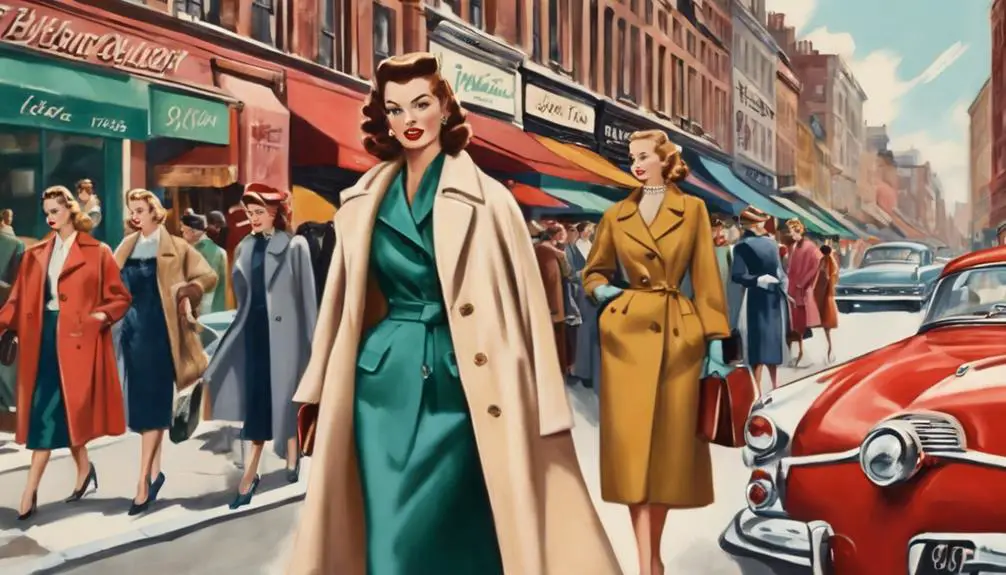
The 1950s marked a transformative period in women's fashion, with influential designers like Christian Dior and Elsa Schiaparelli redefining the wrap coat. Dior's "New Look" popularized the wrap coat, emphasizing a feminine silhouette and hourglass shape through elegant designs. His creations often featured luxurious fabrics and intricate detailing, appealing to affluent women of the era.
Schiaparelli, on the other hand, innovated with bold patterns and unique fabrics, reflecting the artistic trends of the time. Her wrap coats stood out for their creativity, showcasing how fashion could blend art and utility. Pierre Balmain also contributed to this movement, emphasizing luxury and elegance in his wrap coat designs.
The princess coat became a notable style during this period, with its form-fitting bodice and flared hemline mirroring dress lines. These wrap coats frequently incorporated glamorous elements like statement buttons, adding to their allure.
| Designer | Key Features | Signature Style |
|---|---|---|
| Christian Dior | Hourglass silhouette, luxurious fabrics | Elegant and timeless |
| Elsa Schiaparelli | Bold patterns, innovative designs | Artistic and playful |
| Pierre Balmain | Intricate detailing, high-quality fabrics | Sophisticated elegance |
| General Style | Flared hemlines, statement buttons | Feminine and chic |
Fabrics and Textures Used
In the design evolution of women's wrap coats during the 1950s, the choice of fabrics and textures greatly influenced their appeal. The era celebrated luxurious fabrics, which not only offered warmth but also exuded elegance, making the vintage coat a staple in any fashionable woman's wardrobe.
- Wool fleece and cashmere provided a cozy feel
- Faux fur trims elevated the glamour factor
- Tweeds and camel hair added depth to the designs
- Vibrant colors and patterns enhanced the feminine aesthetic
Textures were essential, creating visual interest and contributing to the overall allure of wrap coats. You'd often see coats adorned with real or faux fur, enhancing not just warmth but also texture. Lightweight cotton blends were also popular, especially in clutch coats, allowing for versatile styling while keeping comfort in mind. The vibrant colors chosen during this decade reflected the optimistic spirit of the time, aligning perfectly with the retro feminine aesthetic. Each fabric choice wasn't merely functional; it played a significant role in defining the identity of women's fashion, ensuring that wrap coats remained an essential part of their wardrobe throughout the decade.
Popular Color Trends
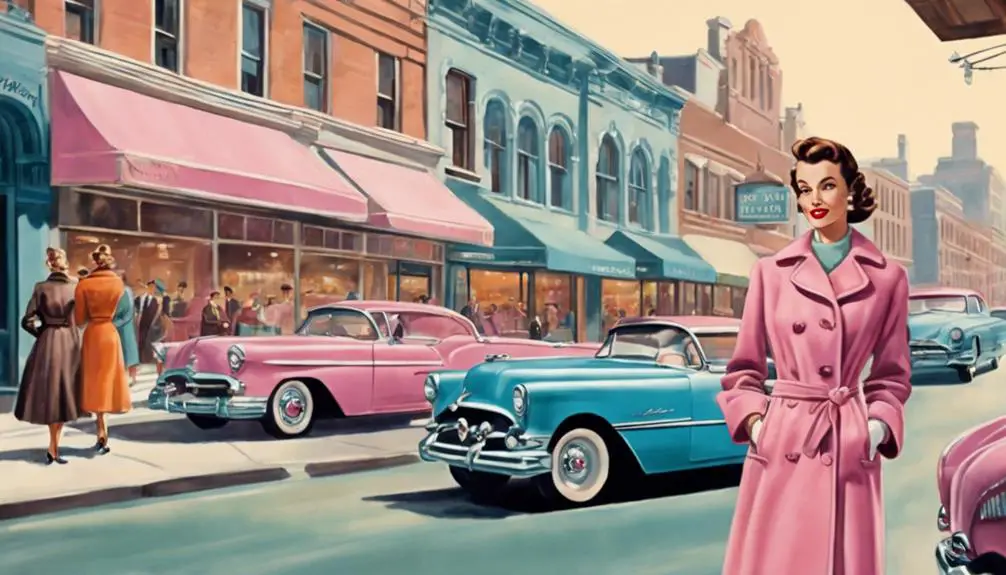
During the 1950s, women's wrap coats showcased a vibrant palette that reflected the era's bold fashion sensibilities. The color trends of this decade were characterized by rich hues, including deep burgundy, vibrant teal, and classic navy, which exuded a luxurious feel. These bold shades became staples for those looking to make a statement.
Alongside these rich tones, pastel colors emerged, offering a fresh and feminine touch with soft pinks, baby blues, and mint greens. These lighter shades perfectly complemented the season's vintage coats, creating a delightful contrast. Neutral tones like camel, beige, and cream remained essential for their versatility, ensuring that wrap coats could be paired effortlessly with various outfits.
Moreover, the introduction of leopard print and other animal patterns added an adventurous flair to the color spectrum, appealing to those who sought a touch of glamour. Bright colors, particularly shades of red and orange, became popular choices that embodied the optimism of post-war fashion.
Here's a quick overview of these trends:
| Color Type | Examples | Characteristics |
|---|---|---|
| Rich Hues | Deep burgundy, vibrant teal | Luxurious, bold |
| Pastel Colors | Soft pink, baby blue | Fresh, feminine |
| Neutral Tones | Camel, beige | Versatile, classic |
Styling Tips and Pairings
With a palette rich in both bold and pastel colors, styling women's wrap coats from the 1950s becomes an exciting endeavor. These coats, characterized by elegant designs and luxurious fabrics like wool and faux fur, offer a sophisticated touch to your vintage wardrobe. Understanding the importance of tag identification can also enhance your vintage fashion experience, allowing you to appreciate the history behind your pieces. To truly embrace the era's charm, consider the following styling tips:
- Opt for a wrap coat featuring a flared hemline to enhance movement and femininity.
- Pair your coat with casual dresses or formal evening gowns for versatile styling options.
- Choose vibrant colors or classic patterns like plaid to make a bold statement.
- Complete your look with coordinated accessories like gloves and stylish hats.
The swing style prevalent in the 1950s emphasizes a playful silhouette, making the wrap coat a perfect choice for various occasions. When you layer these elegant coats over your attire, you not only stay warm but also maintain an air of sophistication. Remember, the right wrap coat isn't just a piece of clothing; it's a statement that reflects the timeless appeal of vintage fashion, allowing you to channel the elegance of a bygone era effortlessly.
Accessories to Complement Wrap Coats
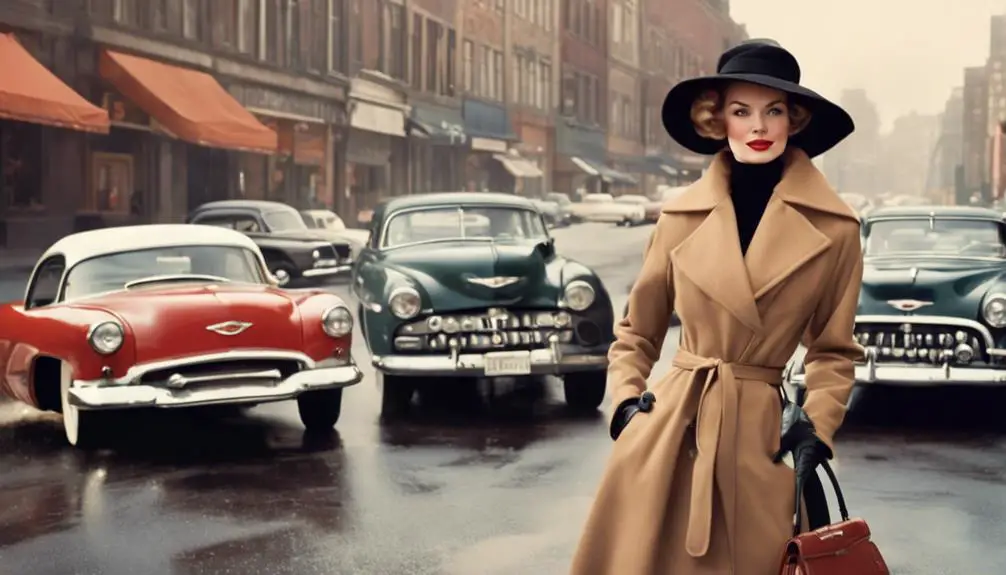
Elegance defines the domain of accessories that beautifully complement women's wrap coats from the 1950s, turning a simple outfit into a sophisticated ensemble. Color-coordinated gloves were essential, enhancing the polished look of your wrap coat while emphasizing the overall elegance of your outfit. Hats, particularly wide-brimmed styles, served as fashionable accents, creating a refined silhouette that perfectly framed your face.
Scarves added both warmth and a stylish touch, whether worn elegantly around your neck or tied to the handle of your handbag. This layering not only provided practicality but also showcased your attention to detail. Statement jewelry played a pivotal role; brooches and earrings elevated the glamour of your wrap coat, reflecting the refined aesthetic typical of 1950s fashion.
Lastly, vintage handbags with structured shapes were favored as accessories, offering a chic and functional complement to your ensemble. These handbags not only completed the look but also added an element of sophistication that was quintessential to the era. By thoughtfully selecting accessories like gloves, hats, scarves, jewelry, and handbags, you can fully embrace the elegance of 1950s fashion while wearing a wrap coat.
Vintage Market for Wrap Coats
The vintage market for women's wrap coats from the 1950s has become a vibrant hub for fashion enthusiasts and collectors alike, reflecting a growing appreciation for timeless style. As you explore this niche, you'll discover that these wrap coats offer a unique blend of history and elegance, with prices typically ranging from $25 to over $200 based on brand and condition.
- Luxurious fabrics like wool, velour, and faux fur
- Elegant designs featuring statement buttons and flared hemlines
- Increasing availability through online platforms
- A commitment to sustainable fashion and eco-friendly shopping
These wrap coats not only cater to casual and formal occasions, but their intricate designs enhance feminine silhouettes. The demand for these vintage pieces highlights a broader trend toward sustainable fashion, as consumers seek unique items that contribute to eco-friendly shopping practices. Online platforms have made it easier than ever to find authentic vintage wrap coats, allowing you to assess their condition and unique features before making a purchase. This resurgence in interest signifies a collective desire to embrace fashion that tells a story while remaining stylish and sustainable.
Modern Interpretations of 1950s Styles
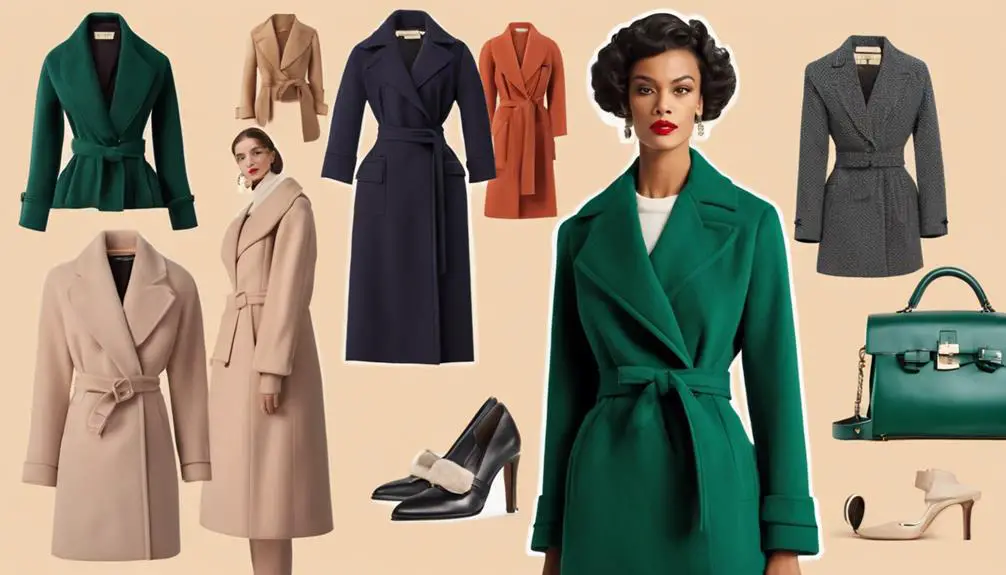
Often, you'll find that modern interpretations of 1950s wrap coats seamlessly blend nostalgic elements with contemporary sensibilities. Designers today draw inspiration from classic silhouettes, emphasizing femininity and elegance reminiscent of Christian Dior's influence on the hourglass figure. You'll notice that many modern wrap coats incorporate vintage-inspired features like statement buttons and flared hems, coupled with luxurious faux fur trims that evoke the era's glamour.
The resurgence of retro styles has made oversized and swing-inspired wrap coats particularly popular, allowing for comfort while maintaining a chic aesthetic that appeals to fashion enthusiasts. These contemporary pieces often feature practical elements, such as adjustable ties and lightweight materials, making them versatile for both casual and formal occasions.
Moreover, you can find modern versions of the iconic princess coat, once a staple of the 1950s wardrobe, now available in a range of sizes, including plus size options. These designs reflect the elegance of the original while catering to diverse body types. By using contemporary fabrics, today's wrap coats maintain the timeless appeal of the past while meeting the needs of modern women.
Frequently Asked Questions
What Coats Were Popular in the 1950s?
In the 1950s, you'd notice princess, swing, and lightweight clutch coats dominating fashion. Each style offered unique silhouettes, combining elegance and practicality, while glamorous fur coats served as luxurious status symbols inspired by Hollywood's influence on trends.
What Were Fur Coats Made of in the 50s?
In the '50s, fur coats primarily used genuine furs like mink and fox, emphasizing luxury. Faux options emerged, offering affordability. Blended fabrics enhanced comfort, while embellishments like buttons added sophistication, showcasing style and craftsmanship of the era.
How Should a Wrap Coat Fit a Woman?
A wrap coat should fit you comfortably at the shoulders and bust, with a secure waist that enhances your silhouette. It should drape elegantly, allowing movement while flattering your figure with tailored sleeves and a flared hem.
What Was the Most Popular Dress in the 1950s?
The most popular dress in the 1950s was the full swing dress, featuring a fitted bodice and flared skirt. It highlighted an hourglass silhouette, embodying femininity and elegance, and became a staple of the decade's fashion.
